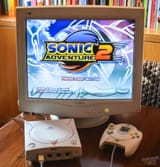Search Results
6/19/2025, 4:54:15 AM
6/19/2025, 4:33:33 AM
Dreamcast was truly ahead of its time
>1998
>Sega of Japan's Katana for Dreamcast
>Hitachi SH4 chips
>PVR on Dreamcast was much better than PSX GPU
>Rarely-used volumetric per-pixel shadows and volumetric fog features
>Order Independent Transparency and is the only system to date that came with OIT at the hardware level
>SFD (Sofdec) video file format primarily used for in-game cutscenes (FMVs)
>16MB of RAM (8x the PS1/Saturn) and 8MB of VRAM
>Native VGA out support
>Plans for HDD support
>1998
>Sega of Japan's Katana for Dreamcast
>Hitachi SH4 chips
>PVR on Dreamcast was much better than PSX GPU
>Rarely-used volumetric per-pixel shadows and volumetric fog features
>Order Independent Transparency and is the only system to date that came with OIT at the hardware level
>SFD (Sofdec) video file format primarily used for in-game cutscenes (FMVs)
>16MB of RAM (8x the PS1/Saturn) and 8MB of VRAM
>Native VGA out support
>Plans for HDD support
6/14/2025, 8:29:36 AM
6/12/2025, 9:44:22 AM
Eternal reminder for Sonic fans
The Mega Drive never really took off in Japan and the people who did buy it were more interested in arcade games. The Saturn did okay in Japan but Sonic was absent. His popularity picked up in the Dreamcast years because of the Adventure games but as we know, it was mostly downhill from there.
It's not that Sonic is unpopular in Japan, it's just that he never achieved Mario type status.
The Mega Drive never really took off in Japan and the people who did buy it were more interested in arcade games. The Saturn did okay in Japan but Sonic was absent. His popularity picked up in the Dreamcast years because of the Adventure games but as we know, it was mostly downhill from there.
It's not that Sonic is unpopular in Japan, it's just that he never achieved Mario type status.
6/12/2025, 7:07:40 AM
>>105566523
>When we were developing the Saturn 3D Controller, that was the first time we had ever tried to design an analog-input controller. We looked at how we could best make an analog controller, and spent a lot of time working on the basic design, control methods, layouts, and all the associated design questions.
>We also looked into all kinds of additional features; stuff like integrated displays, paddle wheel controls, mouse input, motion sensing, infrared, rumble, haptics, voice recognition... many different things. Most of these features proved too costly to have natively on the Saturn 3D pad, but we made sure to design the controller to include an expansion port so those features could be added later.
>We had actually planned out a motion sensor and vibration pack, and even made a prototype. We made sure that the controller's cord ran out of the back, since anything to do with motion sensors that you would have to tilt or shake around would be harder to use with the cord coming out of the front of the controller.
>For the analog inputs, we felt it was essential to use a sensor that wouldn't experience any change in the analog signal from drift or wear. To accomplish that, we used "Hall" elements. We knew we definitely didn’t want resistive sensors. We didn’t add them for the sake of having a selling point, we just saw it as the obvious choice. It wasn’t until 2020 that we saw other companies start making controllers with those same Hall elements. I guess the market finally caught up to the Sega 3D Control Pad, and it only took 25 years.
>When we were developing the Saturn 3D Controller, that was the first time we had ever tried to design an analog-input controller. We looked at how we could best make an analog controller, and spent a lot of time working on the basic design, control methods, layouts, and all the associated design questions.
>We also looked into all kinds of additional features; stuff like integrated displays, paddle wheel controls, mouse input, motion sensing, infrared, rumble, haptics, voice recognition... many different things. Most of these features proved too costly to have natively on the Saturn 3D pad, but we made sure to design the controller to include an expansion port so those features could be added later.
>We had actually planned out a motion sensor and vibration pack, and even made a prototype. We made sure that the controller's cord ran out of the back, since anything to do with motion sensors that you would have to tilt or shake around would be harder to use with the cord coming out of the front of the controller.
>For the analog inputs, we felt it was essential to use a sensor that wouldn't experience any change in the analog signal from drift or wear. To accomplish that, we used "Hall" elements. We knew we definitely didn’t want resistive sensors. We didn’t add them for the sake of having a selling point, we just saw it as the obvious choice. It wasn’t until 2020 that we saw other companies start making controllers with those same Hall elements. I guess the market finally caught up to the Sega 3D Control Pad, and it only took 25 years.
Page 1


